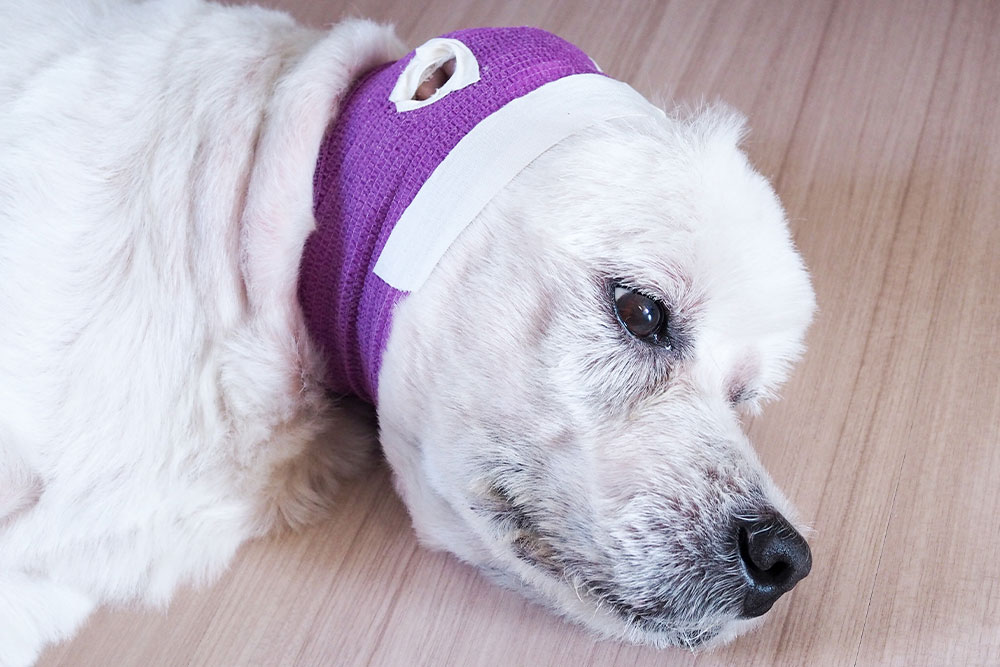Dog Ear Hematomas Explained: How to Spot and Treat This Painful Condition
Excessive head shaking or scratching can cause tiny blood vessels inside a dog’s ear to rupture, leading to a painful swelling known as an ear hematoma. Without prompt care, the ear can become permanently thickened or misshapen. Early treatment not only relieves discomfort but also helps prevent long-term ear damage. Because hematomas are often secondary to infections, allergies, or ear mites, identifying and addressing the root cause is essential for lasting relief.
At Skyway Animal Hospital, we know ear problems can develop suddenly and cause significant pain. Our diagnostic services allow us to pinpoint the cause of your dog’s ear hematoma and provide thorough, compassionate treatment that heals the ear and helps prevent future flare-ups.
What Causes That Swollen Ear Flap in Dogs?
Understanding Ear Hematomas and How They Develop
An ear hematoma occurs when blood vessels inside your dog’s ear flap rupture and fill the space between the skin and cartilage with fluid. The result is a soft, balloon-like swelling that can range from small and localized to large enough to distort the entire ear.
Most ear hematomas develop because dogs shake their heads or scratch their ears vigorously. This trauma breaks delicate blood vessels, allowing blood to pool under the skin. The swelling may appear suddenly, often overnight, and can affect one or both ears.
Common triggers include:
- Ear infections that cause itching and irritation
- Allergies leading to chronic inflammation
- Ear mites or foreign objects lodged in the ear canal
- Trauma from rough play or scratching
Without treatment, hematomas can lead to permanent ear deformities, often called “cauliflower ear.” The cartilage becomes scarred and thickened, changing the shape of the ear flap permanently. Understanding ear hematoma in dogs helps pet owners recognize when professional intervention is necessary. At Skyway Animal Hospital, our wellness and preventative care approach includes regular ear checks to catch problems before they escalate into hematomas.
Recognizing the Warning Signs in Your Dog
Symptoms That Signal an Ear Hematoma
Early detection makes treatment simpler and more effective. Most pet owners first notice something wrong when their dog’s ear suddenly looks swollen or feels different to the touch.
Watch for these signs:
- A soft, fluid-filled swelling on the inner or outer surface of the ear flap
- The ear feels warm or appears red and inflamed
- Your dog tilts their head to one side
- Excessive head shaking or pawing at the affected ear
- Visible discomfort or pain when you touch the ear
- Changes in ear position, with one ear drooping more than usual
The swelling from an ear hematoma can develop rapidly, sometimes within hours of the initial trauma. The ear flap may feel like a water balloon, and dogs often show clear signs of discomfort.
If your dog shows signs of severe pain or distress, our emergency services team can provide immediate evaluation during business hours. For after-hours emergencies, we partner with local animal emergency hospitals to ensure your pet receives urgent care when needed.
Why Do Some Dogs Develop Ear Hematomas?
Identifying Root Causes and Risk Factors
While the immediate cause of an ear hematoma is trauma to the ear flap, the underlying reason for that trauma matters just as much. Dogs don’t shake their heads violently without cause. Something is irritating them, and identifying that trigger prevents recurrence.
Ear infections, also known as “Otitis Externa” rank among the most common culprits. Bacterial or yeast infections cause intense itching and inflammation, prompting dogs to scratch and shake until vessels rupture. Otitis externa involves inflammation of the external ear canal, which creates the perfect environment for infection and subsequent hematoma formation.
Allergies also play a significant role. Environmental allergens like pollen, dust mites, and mold can trigger ear inflammation, as can food sensitivities. Dogs with allergies often develop chronic ear problems that require ongoing management. Understanding dog allergies symptoms and treatment helps owners recognize when their pet’s ear issues stem from systemic inflammation rather than isolated infection.
Certain breeds face higher risk due to ear structure. Dogs with long, floppy ears like Basset Hounds, Cocker Spaniels, and Bloodhounds trap moisture and debris more easily, creating conditions favorable for infection. Breeds prone to allergies, such as Golden Retrievers and Labrador Retrievers, also experience more frequent ear problems.
Other contributing factors include:
- Ear mites, though rare in dogs compared to cats, cause intense itching
- Foreign material like grass awns or foxtails lodged in the ear canal
- Underlying blood clotting disorders that make vessels more fragile
- Previous ear trauma or surgery
Cleaning your dog’s ears properly prevents many ear problems, but technique matters. Improper cleaning can push debris deeper or damage delicate ear structures. Examining and medicating the ears of a dog requires patience and proper technique, especially when inflammation or pain is present.
At Skyway Animal Hospital, our diagnostic capabilities allow us to investigate these underlying causes thoroughly. We use ear cytology, cultures, and allergy testing to pinpoint exactly what’s driving your dog’s ear problems.
What Happens If You Ignore an Ear Hematoma
When an ear hematoma is left untreated, pressure builds inside the ear flap as it fills with blood from broken vessels. The swelling grows tight and painful, and every shake of the head forces more trauma to the delicate tissue. Over time, the repeated shaking and scratching can cause the ear skin to split open, leading to a sudden rupture.
When that happens, blood can splatter across walls, furniture, and flooring- especially if your dog keeps shaking their head. It’s alarming to see, even though your dog isn’t in real danger of bleeding to death. The real harm lies in the ongoing pain, infection risk, and scarring that can leave the ear permanently crumpled or thickened. Prompt veterinary care spares you and your dog that ordeal and prevents a messy, frightening scene at home.
Treatment Options That Address the Problem Completely

Medical and Surgical Solutions for Ear Hematomas
Treating an ear hematoma requires both draining the accumulated fluid and addressing whatever caused the trauma in the first place. Without treating the underlying condition, hematomas often recur, sometimes repeatedly.
Initial treatment typically involves draining the hematoma to relieve the pressure. Your veterinarian may use a needle and syringe to remove the fluid, though this approach often requires multiple treatments as fluid reaccumulates. In some cases, steroids injected into the pocket can help reduce the swelling without surgery, but pets will likely end up with a firm, crinkled ear for life. For more definitive results, surgical intervention creates a more permanent solution.
Surgical repair involves making an incision in the ear flap, removing all clotted blood and fluid, and then placing sutures that hold the skin against the cartilage as healing occurs. These sutures prevent fluid from reaccumulating and help the ear maintain its normal shape. Some techniques use teat cannulas or drains that remain in place for several days, allowing continued drainage while healing progresses.
Our surgical services at Skyway Animal Hospital include both routine hematoma repairs and more complex procedures when ear canal disease requires intervention.
Preventing Recurrence and Supporting Recovery
Home Care Strategies and Follow-Up
After treatment, diligent home care determines whether your dog heals completely or develops complications. Your veterinarian will provide specific instructions based on the treatment method used, but several general principles apply to all cases.
Preventing head shaking during healing is critical. Many dogs require an Elizabethan collar or similar device to keep them from scratching at their ears or rubbing their head against furniture. Some owners find success with protective ear wraps like the No Flap Ear Wrap, which stabilizes the ear and prevents further trauma while allowing air circulation.
Our team at Skyway Animal Hospital provides thorough follow-up care and guidance throughout your dog’s recovery. We understand that each pet has unique needs and risk factors, and we tailor our recommendations accordingly. Building a relationship with your veterinary team ensures we understand your dog’s complete health picture, not just the immediate problem.
Why Quick Action Protects Your Dog’s Ears
Ear hematomas may seem like minor issues, but they cause significant discomfort and can lead to permanent ear deformity without proper treatment. The swollen, heavy ear flap hurts, and the underlying cause continues creating problems until addressed.
At Skyway Animal Hospital, we combine medical expertise with compassionate care, ensuring your dog receives thorough treatment that addresses both symptoms and root causes. Our commitment to individualized care means we take time to understand your pet’s unique story and develop treatment plans that fit your situation.
Whether your dog needs immediate evaluation or you want to discuss preventive strategies for chronic ear issues, we’re here to help. Request an appointment or contact us today. Walk-ins are always welcome, and we’ll work with you to ensure your dog receives the expert care they deserve.







Leave A Comment